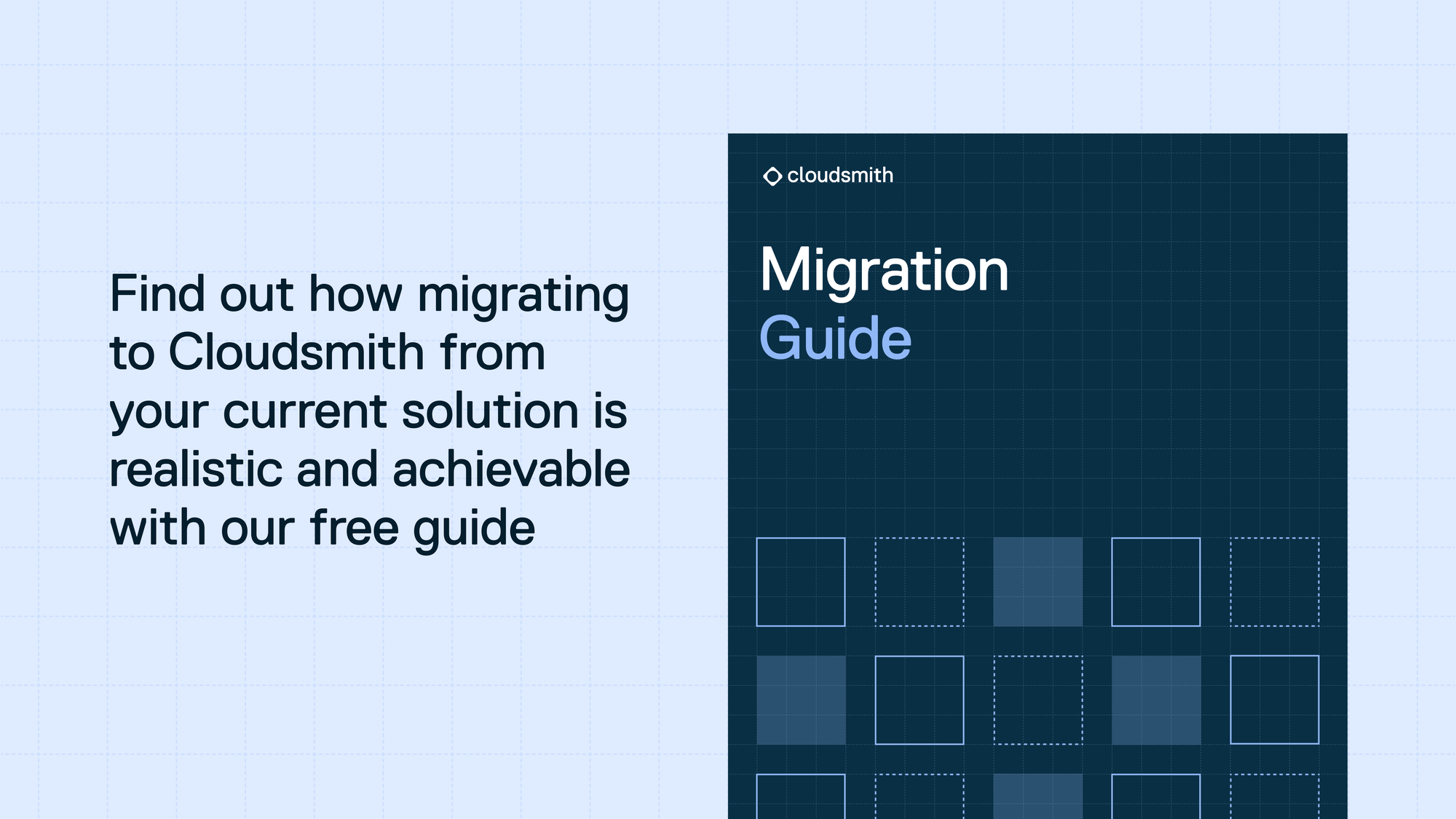Mastering Your JFrog Artifactory Migration: Steps to Success

Migrating from JFrog Artifactory to a new artifact management platform like Cloudsmith can feel like a daunting task. We promise, it’s actually easier and more straightforward than you think! Many organizations have successfully completed migrations away from JFrog Artifactory, even with complex setups and dependencies. If you're looking for a structured, proven approach, our free Cloudsmith Migration Guide offers detailed best practices, a phased migration framework, and expert insights to help make the process seamless.
This guide provides a step-by-step JFrog Artifactory migration strategy and highlights why Cloudsmith is one of the best JFrog Artifactory alternatives.
Why Plan Your JFrog Artifactory Migration?
Migration is basically two things: moving data and re-evaluating workflows. Cloudsmith offers numerous advantages that streamline JFrog migration and ensure your tools align with your long-term goals. With a successful migration, you’ll even minimize downtime and maintain business continuity.
Steps to a Successful JFrog Artifactory Migration
1 - Audit and Prepare Your Repositories
Before beginning your migration from JFrog artifactory, take stock of your current environment:
- Inventory Your Repositories: Identify all hosted repositories and ensure they are up to date.
- Clean Up: You may want to take this opportunity to remove unused or outdated artifacts to simplify the migration process. (Note, this is NOT required, and it may be easier and less risky to just move everything.)
- Document Dependencies: Note any upstream repositories and registries, third-party integrations, and workflows that are dependent on your current setup.
2 - Export Your Artifacts from JFrog Artifactory
Exporting artifacts is the first technical step in migrating from JFrog Artifactory. There are three basic approaches:
- Use Artifactory’s Built-In Tools: Export repositories directly through the Artifactory UI.
- Leverage the JFrog CLI: Use CLI commands to export specific packages or repositories.
- Cloudsmith Migration Toolkit: This powerful tool automates critical aspects of migration, including ensuring your repositories are correctly organized in the new environment (Repository Structure Mapping) and retaining important data during the transfer (Metadata Preservation) to avoid manual updates post-migration.
3 - Import Artifacts into Cloudsmith
After exporting, the next step is importing your artifacts into Cloudsmith:
- Set Up Cloudsmith Repositories: Create your organization and repositories in Cloudsmith, aligning them with your intended structure and best practices. This ensures a clean, scalable setup that supports various formats (e.g., Docker, PyPi, NPM).
- Bulk Import with Cloudsmith CLI: Use the Cloudsmith CLI to streamline the import process, allowing you to efficiently upload multiple artifacts in bulk. Automation tools and CI/CD integrations further enhance this workflow by ensuring consistency in artifact management.
- Preserve Metadata: Ensure that metadata, including version history and dependency information, is maintained during the import process. Preserving metadata is crucial for traceability and accountability, especially as you scale your projects and collaborate across teams
For optimal management, it's essential to follow best practices for repository and package workflows, such as maintaining clear versioning, ensuring secure access control, and leveraging automation for repeatable processes. These practices help streamline workflows, improve security, and ensure consistency in artifact management.
4 - Update Your Build Tools and Integrations
Reconfigure your development tools to integrate with Cloudsmith:
- Update CI/CD Pipelines: Update endpoints in your pipelines to push and pull from Cloudsmith.
- Manage Dependencies Efficiently: Set up upstreams in Cloudsmith to cache and manage third-party libraries from sources like DockerHub, Chainguard, and PyPi.
- Enhance Access Controls: Ensure secure access by configuring advanced authentication methods such as Single Sign-On (SSO), OpenID Connect (OIDC), and API tokens. Additionally, define user roles to manage permissions and maintain a robust security framework.
5 - Validate Your JFrog Artifactory Migration
This is a good time to validate your setup to ensure everything is working as expected:
- Validate Artifacts: Confirm that all packages and metadata are present and accessible in Cloudsmith.
- Run Builds: Test your pipelines to ensure seamless integration with Cloudsmith.
- Fix Any Issues: Address discrepancies early to avoid complications post-migration.
At this point, you will have a performant, secure, highly available single source for all the artifacts and containers flowing into your organization. If you need any assistance, our friendly support team is always ready to help ensure your migration is smooth and successful.
6 - Decommission JFrog Artifactory
Once Cloudsmith is fully operational, safely phase out your old Artifactory system:
- Archive Critical Data: Retain logs and critical data for compliance and historical reference.
- Remove Redundant Integrations: Disconnect tools and workflows tied to Artifactory.
Why Choose Cloudsmith as a JFrog Artifactory Alternative?
Cloudsmith is designed to meet the demands of modern software development. It supports all major package types, offers advanced security features, and simplifies artifact management with a fully managed, cloud-native solution. By switching to Cloudsmith, you can reduce infrastructure overhead, streamline workflows, and scale effortlessly with your needs.
Key Benefits of Migrating to Cloudsmith
Migrating from JFrog Artifactory to Cloudsmith offers significant advantages:
- Universal Package Support: Manage all your artifacts in one place, from Alpine to Docker to Python to Terraform Modules (32 formats in all).
- Cloud-Native Platform: Reduce the total cost of ownership and infrastructure overhead with a fully managed service.
- Advanced Security Features: Benefit from features like signing keys and entitlement tokens to enhance control over the distribution and use of your artifacts.
- Effortless Scalability: Add teams, formats, repositories, upstreams, and geographies without worrying about infrastructure, with a platform built for growth.
Start Your JFrog Artifactory Migration Today!
Migrating your artifact management system is easy, and we’re here to make it even easier. Book a meeting with our experts to discuss your unique needs and learn how Cloudsmith can simplify and enhance your workflows.
"Out of all of the vendors we talked to, Cloudsmith was the one that seemed to want to work with us the most. Right away they were saying, 'Here are all the things we want to do for you. Here are the things we can build…' That won us over. And everything that’s happened since then has only confirmed that initial impression."
— Dave Bresci, Senior Manager at PagerDuty
Master Your JFrog Migration with Cloudsmith
Cloudsmith is more than a repository - it’s a platform designed to empower modern software teams. Start your journey toward streamlined artifact management by connecting with us today. Let’s make your migration a success!
Frequently Asked Questions (FAQs)
- How do I migrate from JFrog Artifactory to Cloudsmith?
Use the Cloudsmith Migration Toolkit to export, import, and validate artifacts, ensuring a smooth JFrog Artifactory migration with minimal downtime. - What are the best practices for Artifactory migration?
Audit repositories, clean up unused data, document dependencies, automate exports, and validate artifacts post-migration for a seamless transition. - Why should I consider JFrog Artifactory cloud migration?
Cloudsmith offers a fully managed, scalable, and secure artifact management solution, reducing infrastructure costs and simplifying workflows. - What are the benefits of using Cloudsmith over JFrog Artifactory?
Cloudsmith provides universal package support, cloud-native efficiency, strong security, and seamless CI/CD integrations for better artifact management. - What tools can I use for JFrog cloud migration?
Use Artifactory’s export tools, JFrog CLI, or Cloudsmith’s Migration Toolkit to automate artifact transfer while preserving metadata.
Make your migration a success
Whether you're planning, mid-move, or finalizing your switch from JFrog Artifactory, our comprehensive guide has you covered.
It’s designed for DevOps leads, platform teams, and engineering managers ready to modernize artifact management.

Get your copy of our Migration Guide for a more detailed overview of how we’ve helped organizations like yours migrate from Artifactory to Cloudsmith.
Liked this article? Don\'t be selfish (:-), share with others: Tweet

